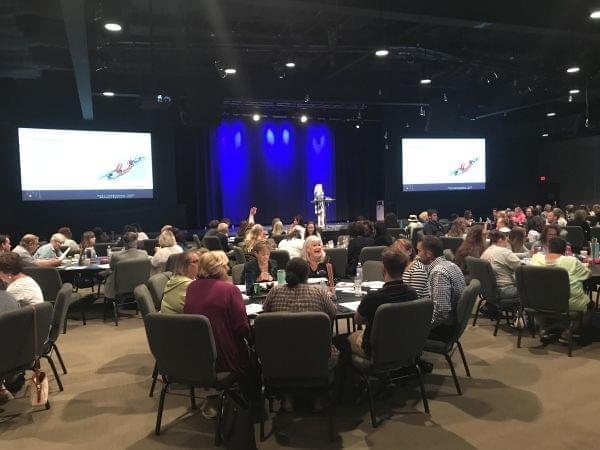Educators Learn To Spot Domestic Violence And Human Trafficking Warning Signs

Speakers teaching prevention tools at the Domestic Violence and Human Trafficking summit in Rockford. Peter Medlin/WNIJ
When we think about preventing domestic violence and human trafficking, we may not think that one of the first lines of defense against these issues is standing at the front of our classrooms.
But who is in a better position to catch the initial warning signs of these issues and take action than the people who often spend as much time with kids as their parents? That’s exactly what area educators from every age range and every discipline learned how to do this week.
Megan Brechon is the Executive Director at Children’s Safe Harbor and was one of the speakers at the event. She presented primarily on domestic violence and the lenses of trauma teachers can look through when identifying these warning signs.
“I think often times when children are having educational struggles or behavioral struggles, we often look at those children and ask what’s wrong with you, instead of looking at maybe what happened to you and how that’s impacting your ability to be an active participant in your education," said Brechon.
The warning signs can be somewhat different for students of different ages, Brechon says, but there are common threads that can run through a person’s life that experiences domestic violence -- especially at a young age.
“Those children who experience domestic violence in their home can then become teens who experience domestic violence in their dating relationships and then become adults who are raising kids who are experiencing domestic violence," said Brechon. "We see this generational cycle sometimes.”
Human trafficking can be an issue that some have a hard time believing is even happening in their own community, says elementary school physical education teacher Dave Packer, because they don’t know either the statistics or people who have been victims of it.
“Your initial thought is that ‘it’s sex trafficking, it’s foreign; it’s happening, they’re grabbing these kids and they’re throwing them overseas’ -- and that’s really not the case,” said Packer.
For Emily White, a truancy interventionist at the Youth Services Network, the presentations on sex trafficking were especially eye-opening.
“Actually the trafficking, getting more knowledge about what exactly that is has skewed what I’ve known previously," said White. "I always put drugs and prostitution underneath that umbrella, and to realize that there is a distinction between them.”
Jennifer Cacciapaglia is the manager of the Rockford Mayor’s Office of Domestic Violence and Human Trafficking Prevention. Along with other local groups, they helped organize the event at Heartland Community Church.
“We’ve reached a point specifically in our community, in Rockford, Illinois, where we have the right people at the table to say ‘we have to do something about this.' Something should have been done a long time ago,” said Cacciapaglia.
Educators are already asked to do a lot in the classroom, says Brechon, and the additional responsibility might seem overwhelming. But she hopes that this new knowledge and training will make them more comfortable dealing with these situations.
“You’ll know where it’s coming from and what it’s rooted in and where to send those children for help, as opposed to feeling like you need to fix it,” she said.
The training was helpful for Dave Packer, who couldn’t help but think back on times in his career where this training could have been useful.
“I’ve spent the last 16 years at the high school level, and just thinking back to some of the experiences and conversations that I’ve overheard or been involved with some of the kids, and, boy. Talk about red flags signs of things you need to be aware of,” said Packer.
Besides teachers-- administrators, bus drivers and others involved in education from across northern Illinois took part in the training. They all hope they’ll be ready to spot those warning signs when school comes back in session later this month.
Links
- How To Be News Literate; Immigrant Victims Of Domestic Violence; State Politics Updates
- New State Budget Is Good News For Domestic Violence Agency
- Domestic Violence Agencies Struggle As State Owes Millions; ‘Taxpayer Bargain’ Proposal
- Illinois Commits $0 Against Domestic Violence
- Legislators Consider Emergency Funding For Domestic Violence Programs

